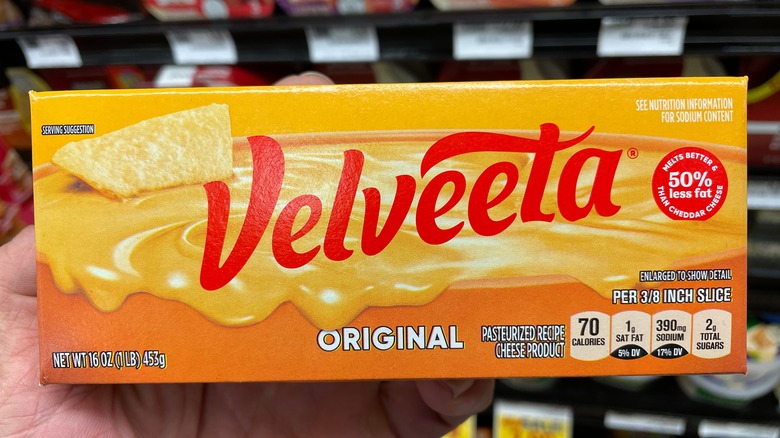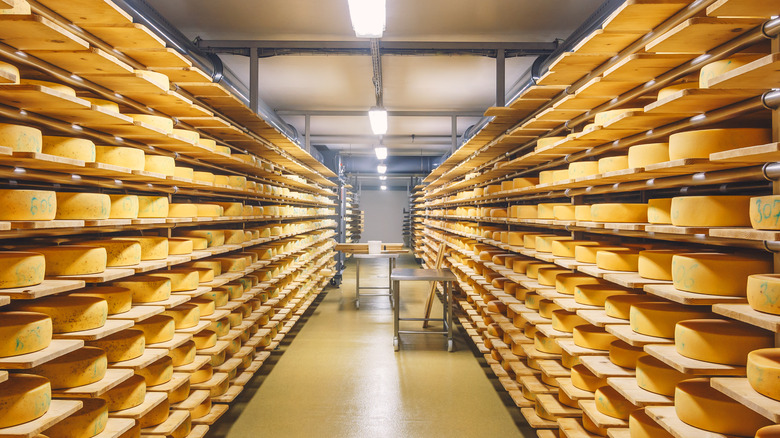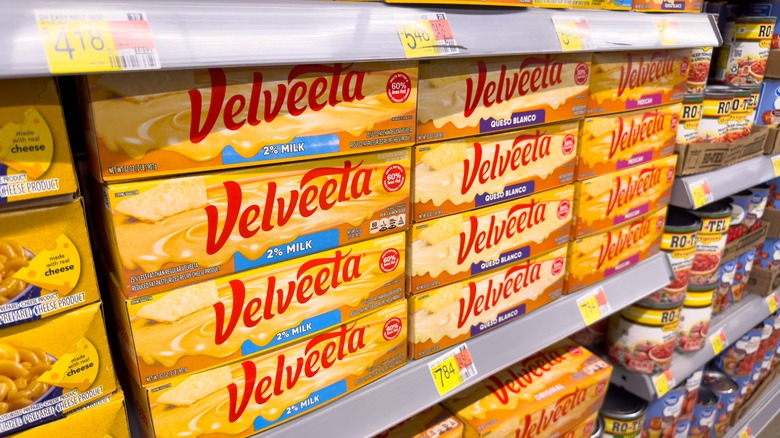What Kind Of Cheese Is Velveeta?
Look, high-end cheeses are great. No one is hating on high-end cheeses; they certainly have their uses, like charcuterie boards or when you want to feel fancy. But sometimes a recipe calls for something that's ... well, let's say a little more industrial-grade. Sometimes, you just need a big block of cheese to melt as part of a recipe, typically working in concert with other cheeses in dishes where you're making a quick and easy cheese sauce for mac and cheese. More expensive cheeses are likely to break, so you want something that will hold its texture. In those instances, you're going to reach for the Velveeta.
But what kind of cheese is Velveeta? The answer, it turns out, is that it is not cheese at all. It may be galling when people make fun of the silly Americans with their plastic cheese, but in this case, Velveeta, in fact, cannot legally be classified as cheese (which is why it isn't labeled as such). It certainly has uses in cooking, but Velveeta is technically a cheese analog. It was, however, originally made of cheese. Well, mostly.
Velveeta was created to avoid food waste
Velveeta's history dates back further than you might think. In the second decade of the 1900s, a cheese purveyor in New York called the Monroe Cheese Company was producing a lot of broken or out-of-shape cheese wheels that it couldn't sell. In 1918, in an attempt to salvage something from all this excess product going to waste, the company hired a cheese expert named Emil Frey.
Frey's solution was simple and elegant: He added whey (a dairy and cheese byproduct) back into the cheese on the stove, discovering that the process resulted in an entirely new product with a surprisingly rich melted consistency. He called it "velveeta" on account of the melted version having the consistency of velvet.
The product went to market quickly, and in 1923, the Velveeta Cheese Company became its own brand. In 1927, it was bought out by Kraft Foods. Though they kept the name and purpose of Velveeta, the company states they changed the internal formula to the point it could no longer be classified as cheese and is instead branded as a "pasteurized prepared cheese product."
Velveeta is still a dairy product, even if it's not a cheese
That recipe change has stuck through to today when Velveeta still contains no cheese. Its current ingredient list consists of skim milk, milk, canola oil, milk protein concentrate, sodium phosphate, and a mix of additives and preservatives. So it's definitely a dairy product, and anyone who says it's plastic is wrong. It's just also not technically a cheese, according to FDA regulations.
But this isn't to say that Velveeta doesn't have a clear usage in cooking. Even if it's not technically cheese, it shares a trait with American cheese that has a useful purpose in cooking: Its low melting point. When you melt a lot of higher-end cheeses, some weird stuff can happen to them. As anyone who's ever tried to make a cheese sauce with just cheddar can tell you, not only does it tend to get oily, but it also coagulates faster than you might want. You can get around this with various cheese blends that counterbalance each other, but even then the results might not be up to spec.
Products like Velveeta are designed to melt smoothly, and when you add them to other blends it imparts that textural stability to everything you throw in there. And to think: It's all because Velveeta isn't actually cheese at all.


